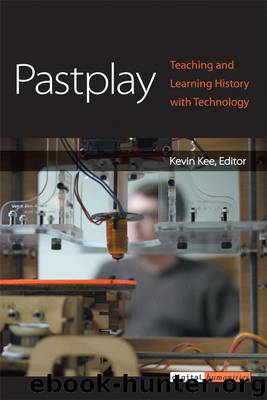Pastplay: Teaching and Learning History with Technology by Kee Kevin

Author:Kee, Kevin
Language: eng
Format: epub
Publisher: The University of Michigan Press
Published: 2018-05-15T00:00:00+00:00
Page 172 →
Page 173 →
With Technology
Page 174 →
Page 175 →
EIGHT
Making and Playing with Models
Using Rapid Prototyping to Explore the History and Technology of Stage Magic
William J. Turkel and Devon Elliott
At sites around the world, self-identified makers, crafters, hackers, “edupunks,” and DIY (do-it-yourself) fabricators are forming a community that is in the process of taking on all of the hallmarks of a new social movement.1 The campaign is probably best summed up by MAKE magazine: “we celebrate your right to tweak, hack, and bend any technology to your will.” MAKE is published by O’Reilly Media, whose motto is “spreading the knowledge of technology innovators.” In addition to MAKE, O’Reilly also publishes a popular series of books on hacking (e.g., Tom Igoe’s Making Things Talk) and hosts blogs and forums.2 Articles in MAKE profile prominent makers, crafters, and hackers and provide step-by-step instruction in building projects at a variety of skill levels. The magazine also editorializes against practices like the copy restriction of software and media and the confiscation of Swiss army knives and multi-tools in airports, and in favor of the open source ethos and of products that invite users “to look inside and see the moving parts . . . make repairs and improvements, and even harvest components once the product ceases to be useful.”3
O’Reilly sponsors a national meeting (the Maker Faire) and provides publicity for local hacker-artist groups like Dorkbot, which meets in about eighty cities worldwide, including Vancouver, Toronto, Ottawa, and Montreal.4 In addition to participating in real-world activities, community members are able to perform online in a variety of forums—including a do-it-yourself instruction website called Instructables—rehearsing core values of sharing and openness, resourcefulness, a can-do attitude, and a willingness Page 176 →to open the black box. If they wish, they can even buy T-shirts with slogans like “If you can’t open it, you don’t own it,” “re-use, re-cycle, re-make,” “hacking is not a crime!” and “Make: void your warranty, violate a user agreement, fry a circuit, blow a fuse, poke an eye out . . .” When President Barack Obama celebrated “the risk-takers, the doers, the makers of things” in his 2009 inaugural address, O’Reilly immediately emblazoned the phrase on a T-shirt.5
The maker community extends far outside the ambit of O’Reilly Media, of course, overlapping with many other interest groups. It includes a global network of hackerspaces, workshops operated by community members who wish to share ideas, tools, and techniques, and to work collaboratively on projects.6 It includes efforts to crowdsource the production of everything from automobiles to prosthetics.7 And, most relevant to the work we describe here, it includes groups of people dedicated to producing software (like the programming language Processing), hardware platforms (like Arduino), and computer-controlled machines that are able to print small 3D objects (like RepRap).8 We discuss all three of these technologies below. In each case, the designers and makers profess an ethic of open source, making tutorials, plans, software, and construction details freely available online.9
The present conjuncture—of making as a new social
Download
This site does not store any files on its server. We only index and link to content provided by other sites. Please contact the content providers to delete copyright contents if any and email us, we'll remove relevant links or contents immediately.
| Arts & Humanities | Health |
| Language Arts | Library Skills |
| Mathematics | Reading & Phonics |
| Science & Technology | Social Studies |
The Art of Coaching Workbook by Elena Aguilar(51083)
Trainspotting by Irvine Welsh(21574)
Twilight of the Idols With the Antichrist and Ecce Homo by Friedrich Nietzsche(18572)
Fangirl by Rainbow Rowell(9180)
Periodization Training for Sports by Tudor Bompa(8217)
Change Your Questions, Change Your Life by Marilee Adams(7692)
This Is How You Lose Her by Junot Diaz(6839)
Asking the Right Questions: A Guide to Critical Thinking by M. Neil Browne & Stuart M. Keeley(5712)
Grit by Angela Duckworth(5557)
Red Sparrow by Jason Matthews(5429)
Paper Towns by Green John(5142)
Room 212 by Kate Stewart(5075)
Ken Follett - World without end by Ken Follett(4688)
Housekeeping by Marilynne Robinson(4399)
The Sports Rules Book by Human Kinetics(4348)
Double Down (Diary of a Wimpy Kid Book 11) by Jeff Kinney(4245)
Papillon (English) by Henri Charrière(4230)
The Motorcycle Diaries by Ernesto Che Guevara(4054)
Exercise Technique Manual for Resistance Training by National Strength & Conditioning Association(4025)
